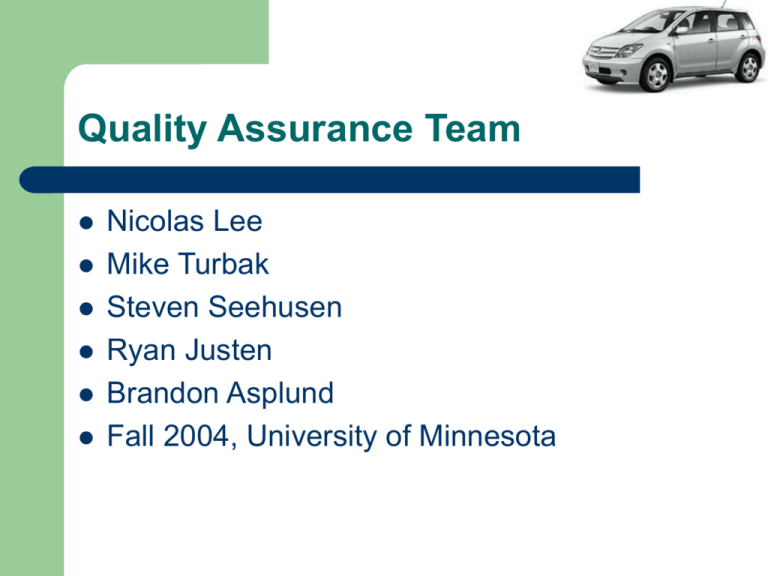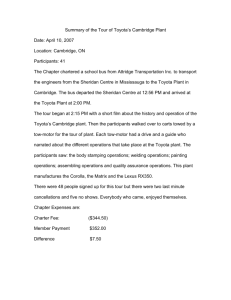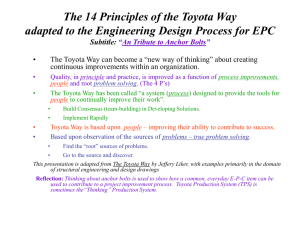Quality Management Team
advertisement

Quality Assurance Team Nicolas Lee Mike Turbak Steven Seehusen Ryan Justen Brandon Asplund Fall 2004, University of Minnesota The Toyota Production System Unique production system – – Allows for continuous quality improvement Rated best vehicle in all categories for quality by JD Power GM, Chrysler, and Ford have tried to develop Toyota like production systems Scientific method is ingrained in Toyota’s production process Teaches the scientific method to all levels of the organization The Four Rules The four rules guide design, operation, and improvement for every product – – – – Rule 1: Scope shall be clearly defined Rule 2: Every customer-supplier connection must be direct and unambiguous Rule 3: The pathway for every product and service must be simple and direct Rule 4: All improvements must be made in accordance with the scientific method Rule 1 All work shall be highly specified Scope is clearly defined – Case study: seat installation Bolts are always tightened in the same order Time taken to turn each bolt is specified Torque of each bolt is specific value Rule 2 Every customer-supplier connection must be direct – Case study: seat installation Acquisition of seat bolt covers by installer Request is given to materials handler Request specifies part number, quantity of parts, location of part supplier, and location of the installer Coordinated materials handling prevents time lost in production Rule 3 The pathway for every product and service must be simple and direct – Case study: seat installation Seat installer requests more plastic bolts covers No forks or loops in supply chain Installer – materials handler – designated supplier Goods flow from to specific person or machine Rule 4 All process changes must be made in accordance with the scientific method – Case study: edging tape installers Initially not responsible for solving problems Assigned a leader to train them formulate and test hypotheses Using the scientific method they reduced defect rates by 90% Toyota’s Ideal Production System The output of an ideal person or machine is: – – – – – Defect free Can be delivered one request at a time Can be supplied on demand in the version requested Can be delivered immediately Can be produced without wasting labor, energy, or other resources Summary of Quality Control Define: Define the problem/opportunity, process, and customer requirements Measure: Define measures, collect, compile, and display data Analyze: Scrutinize process details to find improvement opportunities Improve: Generate solutions and ideas for improving the problem Control: Track and verify the stability of the improvements and the predictability of the solution www.kathyschwalbe.com References Spear, Steven and H.Kent Bowen “Decoding the DNA of the Toyota Production System." Harvard Business Review Sept-Oct 1999. 97-106. “Best Initial Quality by JD Power." JD Power and Associates. 2004. http://www.jdpower.com/cc/auto/releases/search.asp?CatID=1 http://www.toyota.com






